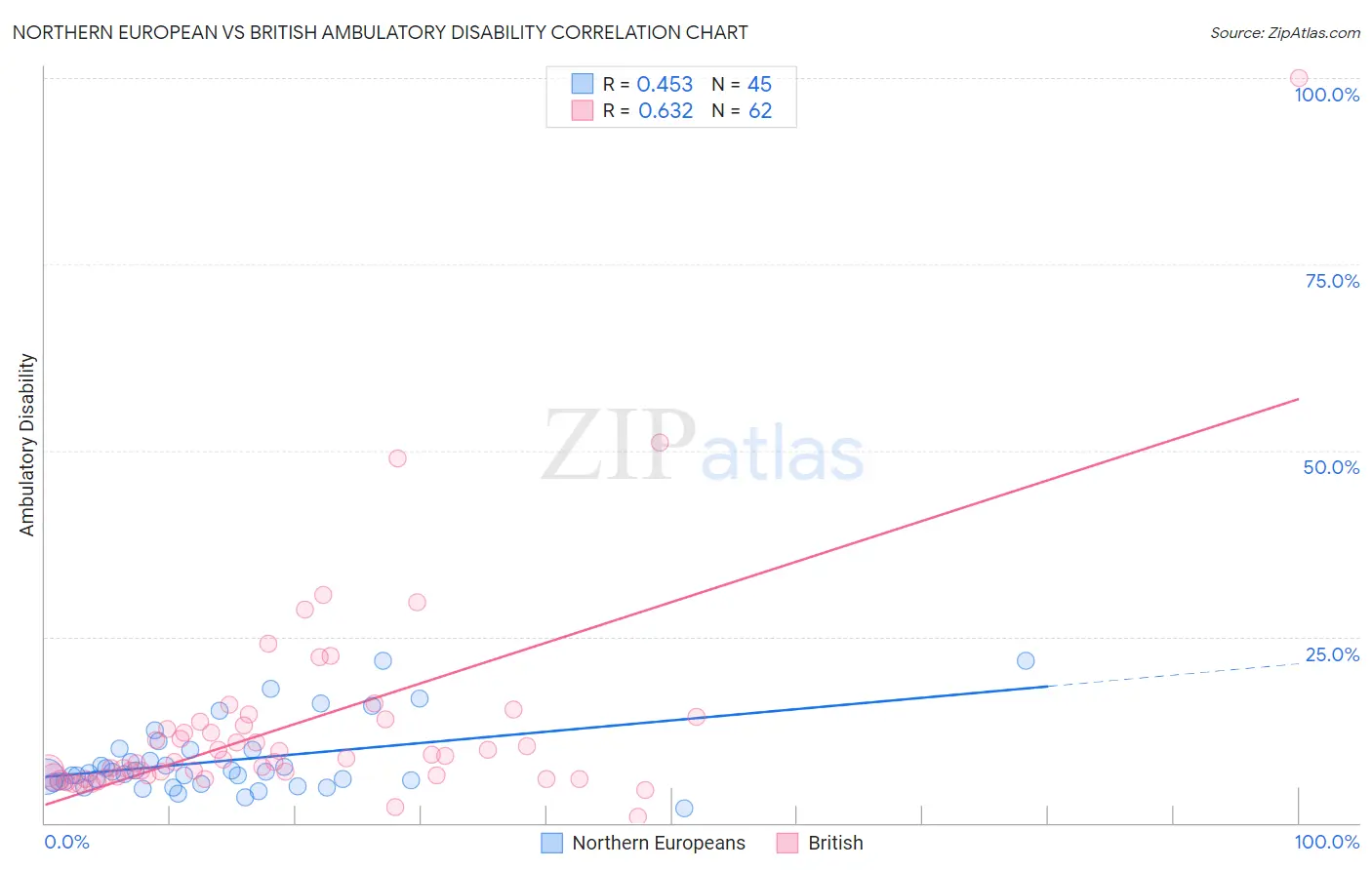Northern European vs British Ambulatory Disability
COMPARE
Northern European
British
Ambulatory Disability
Ambulatory Disability Comparison
Northern Europeans
British
6.0%
AMBULATORY DISABILITY
71.8/ 100
METRIC RATING
156th/ 347
METRIC RANK
6.2%
AMBULATORY DISABILITY
34.3/ 100
METRIC RATING
188th/ 347
METRIC RANK
Northern European vs British Ambulatory Disability Correlation Chart
The statistical analysis conducted on geographies consisting of 405,984,398 people shows a moderate positive correlation between the proportion of Northern Europeans and percentage of population with ambulatory disability in the United States with a correlation coefficient (R) of 0.453 and weighted average of 6.0%. Similarly, the statistical analysis conducted on geographies consisting of 531,154,282 people shows a significant positive correlation between the proportion of British and percentage of population with ambulatory disability in the United States with a correlation coefficient (R) of 0.632 and weighted average of 6.2%, a difference of 2.1%.

Ambulatory Disability Correlation Summary
| Measurement | Northern European | British |
| Minimum | 1.9% | 0.87% |
| Maximum | 21.8% | 100.0% |
| Range | 19.9% | 99.1% |
| Mean | 8.3% | 13.1% |
| Median | 6.7% | 8.6% |
| Interquartile 25% (IQ1) | 5.5% | 6.3% |
| Interquartile 75% (IQ3) | 9.9% | 13.6% |
| Interquartile Range (IQR) | 4.3% | 7.3% |
| Standard Deviation (Sample) | 4.7% | 14.6% |
| Standard Deviation (Population) | 4.6% | 14.5% |
Similar Demographics by Ambulatory Disability
Demographics Similar to Northern Europeans by Ambulatory Disability
In terms of ambulatory disability, the demographic groups most similar to Northern Europeans are Immigrants from Scotland (6.0%, a difference of 0.020%), Ghanaian (6.0%, a difference of 0.030%), Immigrants from Fiji (6.0%, a difference of 0.050%), Immigrants from Latvia (6.0%, a difference of 0.050%), and Central American (6.0%, a difference of 0.13%).
| Demographics | Rating | Rank | Ambulatory Disability |
| Lithuanians | 81.9 /100 | #149 | Excellent 6.0% |
| Maltese | 81.6 /100 | #150 | Excellent 6.0% |
| Greeks | 79.6 /100 | #151 | Good 6.0% |
| Immigrants | Austria | 78.8 /100 | #152 | Good 6.0% |
| Syrians | 75.5 /100 | #153 | Good 6.0% |
| Immigrants | Croatia | 75.1 /100 | #154 | Good 6.0% |
| Immigrants | Scotland | 72.1 /100 | #155 | Good 6.0% |
| Northern Europeans | 71.8 /100 | #156 | Good 6.0% |
| Ghanaians | 71.3 /100 | #157 | Good 6.0% |
| Immigrants | Fiji | 71.2 /100 | #158 | Good 6.0% |
| Immigrants | Latvia | 71.1 /100 | #159 | Good 6.0% |
| Central Americans | 69.8 /100 | #160 | Good 6.0% |
| Immigrants | Belarus | 69.2 /100 | #161 | Good 6.1% |
| Nigerians | 67.1 /100 | #162 | Good 6.1% |
| Lebanese | 66.2 /100 | #163 | Good 6.1% |
Demographics Similar to British by Ambulatory Disability
In terms of ambulatory disability, the demographic groups most similar to British are Ukrainian (6.2%, a difference of 0.020%), Immigrants from Western Africa (6.2%, a difference of 0.050%), Carpatho Rusyn (6.2%, a difference of 0.060%), European (6.2%, a difference of 0.11%), and Immigrants from Guatemala (6.2%, a difference of 0.14%).
| Demographics | Rating | Rank | Ambulatory Disability |
| Swiss | 43.1 /100 | #181 | Average 6.1% |
| Serbians | 42.8 /100 | #182 | Average 6.1% |
| Immigrants | Thailand | 42.2 /100 | #183 | Average 6.1% |
| Immigrants | Ghana | 41.2 /100 | #184 | Average 6.1% |
| Immigrants | Bosnia and Herzegovina | 37.2 /100 | #185 | Fair 6.2% |
| Europeans | 36.2 /100 | #186 | Fair 6.2% |
| Carpatho Rusyns | 35.3 /100 | #187 | Fair 6.2% |
| British | 34.3 /100 | #188 | Fair 6.2% |
| Ukrainians | 34.0 /100 | #189 | Fair 6.2% |
| Immigrants | Western Africa | 33.4 /100 | #190 | Fair 6.2% |
| Immigrants | Guatemala | 31.9 /100 | #191 | Fair 6.2% |
| Immigrants | Western Europe | 31.6 /100 | #192 | Fair 6.2% |
| Guatemalans | 30.0 /100 | #193 | Fair 6.2% |
| Alaska Natives | 29.8 /100 | #194 | Fair 6.2% |
| Belgians | 28.6 /100 | #195 | Fair 6.2% |